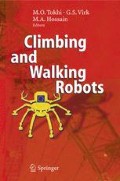Abstract
The paper points out the progress in the exploitation of high, fast and precise non-contact velocimetry for robot applications. A technique for the precise measurement of the speed between two sliding surfaces has been developed during the research project for the realisation of an autonomous robot. The robot is devoted to the scouting of dangerous sites and to the execution of measurements in these places for the exploration of an extreme Antarctica environment (RAS project). This technique is based on the precise calculation of the common movement of a laser speckle field. This approach allows the realisation of a velocimeter suitable for use in extreme conditions. A description of the adopted methodology and the obtained results are the main topic of our work.
Access this chapter
Tax calculation will be finalised at checkout
Purchases are for personal use only
Preview
Unable to display preview. Download preview PDF.
References
Fercher A. F. (1980) Velocity measurement by first-order statistics of time-differentiated laser speckles. Opt. Commun, vol. 33, pp. 129–135.
Fercher A. F., Peukert M. and Roth E. (1986) Visualization and measurement of retinal blood flow by means of laser speckle photography. Opt. Eng., vol. 25, pp. 731–735
Aliverdiev A., Caponero M., Moriconi C. (2002) Speckle Velocimeter for a Self-Powered Vehicle. Technical Physics, vol. 47, no. 8, pp. 1044–1048.
Aliverdiev A., Caponero M., Moriconi C. (2003) Speckle-velocimeter for robotized vehicles. Proceedings of the SPIE. ALT’02 International Conference on Advanced Laser Technologies. Edited by Weber, Heinz P.; Konov, Vitali I. Graf, Thomas., vol. 5147, pp. 140–147
Aliverdiev A., Caponero M., Moriconi C. (2003) Some Issues Concerning the Development of a Speckle Velocimeter. Technical Physics, vol. 48, no. 11, pp. 1460–1463.
Author information
Authors and Affiliations
Editor information
Editors and Affiliations
Rights and permissions
Copyright information
© 2006 Springer-Verlag Berlin Heidelberg
About this paper
Cite this paper
Aliverdiev, A., Caponero, M., Moriconi, C., Fichera, P.A., Sagratella, G. (2006). New Advances on Speckle-velocimeter for Robotized Vehicles. In: Tokhi, M.O., Virk, G.S., Hossain, M.A. (eds) Climbing and Walking Robots. Springer, Berlin, Heidelberg. https://doi.org/10.1007/3-540-26415-9_94
Download citation
DOI: https://doi.org/10.1007/3-540-26415-9_94
Publisher Name: Springer, Berlin, Heidelberg
Print ISBN: 978-3-540-26413-2
Online ISBN: 978-3-540-26415-6
eBook Packages: EngineeringEngineering (R0)

